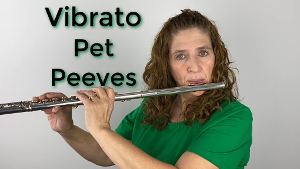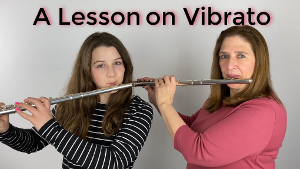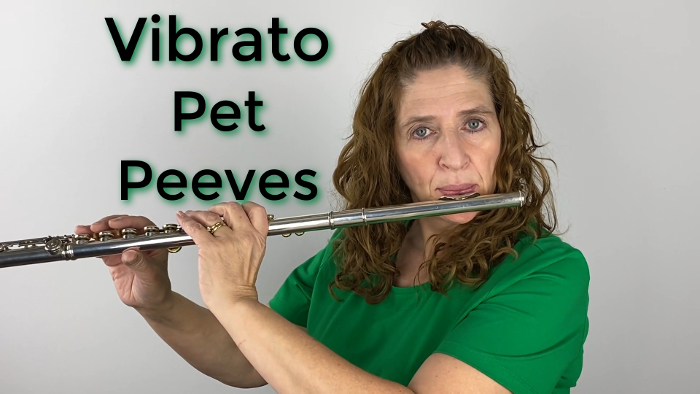Do you listen to your vibrato when you practice a solo? Are you sure that you are in control of your vibrato? I think the answer to those questions is a resounding no! For many flutists, the vibrato “job” is done once it sounds good and you can play with vibrato without thinking about it.
But our job is not done. Vibrato has a way of sneaking on and off notes. Sometimes a vibrato is on some notes, but not on other notes. We must learn to control vibrato. It should be used as a tool for beautiful color on solos, not just a mundane action that occurs without thought.
Once you begin to really listen to your vibrato, you may notice your vibrato falls into one or more of my pet peeve categories. Then, it will begin to drive you crazy!
At some point or another we have all fallen into a vibrato trap. It’s time now to break free!
I would guess that I have found, focused on, and then fixed at least one of these vibrato pet peeves in absolutely every single one of my students. However, I first found and fixed them in me too!
These little habits begin because we don’t take every note captive. That is, we don’t analyze every note. However, if we take some time to look closely at the typical places where these pet peeves occur, we can then prevent or fix most of them. At least those that occur without our knowledge.
Vibrato is a funny thing and we all do it differently. That’s a great thing because that’s what makes us all sound differently when playing a Mozart concerto or a Poulenc Sonata. We can all sound a little bit different because our sound is different, our vibrato is different and the color of our sound is unique to us as individual flutists. The problem I’m talking about is not how we do vibrato, but aspects that we don’t control in our vibrato.
Pet Peeve #1: Vibrato on One 16th Note, But Not the Next 16th Note
This is the biggest vibrato pet peeve that I have when there are a group of 16th notes where 1 and 3 have vibrato and 2 and 4 do not. It may come in the opposite flavor where 2/4 have vibrato 1/3 do not. (I demonstrate this effect in the video below.) It isn’t so much that it sounds terrible, but that there is not consistency in the vibrato.
Sometimes this effect interrupts the musical flow of the phrase. Often this particular trouble with vibrato is so subtle that you have no idea it is going on. It’s quite eye opening when you can identify yourself doing it. I’m all for a cessation of vibrato from time to time, but only if it is your choice not a random spot at which the vibrato mysteriously fades out unbeknownst to the performer!
I had a teacher that brought this to my attention a long time ago. And here I am at my age still thinking about it and making sure that it doesn’t occur in my playing. Sometimes I have to point the finger right back at me!
Play through some of these slow pieces that you have, and think about all of your notes. Are you putting vibrato on everything? And if you’re not, did you have a real reason? When I talk to my students about this, I ask them if they have a musical reason to not use vibrato on that particular note. If so, I ask them to convince me that the note shouldn’t have vibrato. But most of the time, they have no clue that they were leaving vibrato off some notes.
So, be sure to analyze whether you are choosing to put vibrato on each and every note.
Pet Peeve #2: Not Using Vibrato Through a Taper
Another vibrato problem is not carrying vibrato through to the end of a taper. This is when there is a long taper that you used vibrato on the beginning of the note, but as you taper, the vibrato just stops.
Perhaps at the very, very tip of that taper the vibrato can stop just before the note fades into obscurity. But the vibrato shouldn’t stop before then.
Now, there are definitely pieces I play such as Debussy’s Syrinx where I feel that vibrato at the very end is not musically appropriate. So, I choose to end the vibrato sooner. In those instances, it becomes a conscious decision exactly when to end the vibrato. The vibrato doesn’t end on its own without my knowledge. Even if, in the end you decided to use no vibrato, make sure there is no vibrato only when you’ve decided to not use vibrato.
Pet Peeve #3: Vibrato That Never Stops
The last pet peeve is the vibrato that never stops. I’m talking about a vibrato that you don’t control and that never changes. We want vibrato that we control. If I play a Baroque solo, then I need vibrato that is adjusted for that style. I wouldn’t want a very present fast and obtrusive vibrato. Contrastingly, if I play a contemplative 21st century piece, then I might not use any vibrato at all. The bottom line is I want to be in charge of how fast it goes and when I use it. Because sometimes the answer to not have vibrato at all. But I want to be in control of that decision. I’ve had and heard so many flutists that never change their vibrato. It just never varies. Let me tell you, it isn’t just me that finds that sort of “always on – never changing” vibrato will get on my nerves.
Vibrato has to change. It has to mold and grow based on the piece you are performing. If your vibrato stays at that fast-present level, then everything you play is going to basically sound the same.
Those are my 3 vibrato pet peeves. Work at your vibrato. Make it be alive and something that you practice daily. Be able vary the speeds and the lightness or heaviness of it. If you’ve never done that, it’s a discipline that you can learn. You can discipline yourself to control your vibrato. Slow it down, speed it up. Be able to maneuver your vibrato. I need to have all those tools of vibrato in my tool bucket so that I can use them for the pieces that I’m performing.
Vibrato pet peeves, something new to work on!
Have Fun!
DoctorFlute
Watch me demonstrate this: Vibrato Pet Peeves on the Flute – FluteTips 117

Live Flute Lesson on Vibrato with 12-Year-Old Student Waverly – FluteTips 122
Watch me as I teach my 12-year-old daughter in real-time how to play with vibrato:


